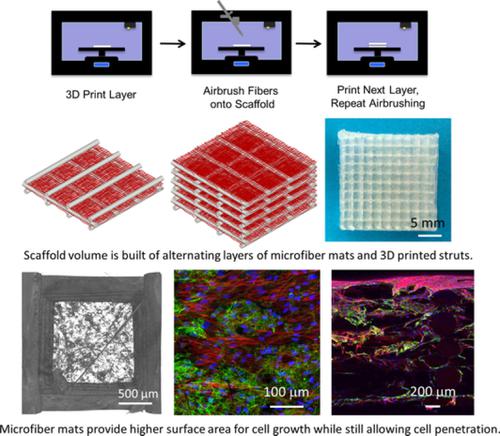当前位置:
X-MOL 学术
›
J. Biomed. Mater. Res. Part A
›
论文详情
Our official English website, www.x-mol.net, welcomes your
feedback! (Note: you will need to create a separate account there.)
A step toward engineering thick tissues: Distributing microfibers within 3D printed frames.
Journal of Biomedical Materials Research Part A ( IF 3.9 ) Pub Date : 2019-12-24 , DOI: 10.1002/jbm.a.36838 Joseph Molde 1 , Joseph A M Steele 1 , Alexandra K Pastino 1 , Anisha Mahat 1 , N Sanjeeva Murthy 1 , Joachim Kohn 1
Journal of Biomedical Materials Research Part A ( IF 3.9 ) Pub Date : 2019-12-24 , DOI: 10.1002/jbm.a.36838 Joseph Molde 1 , Joseph A M Steele 1 , Alexandra K Pastino 1 , Anisha Mahat 1 , N Sanjeeva Murthy 1 , Joachim Kohn 1
Affiliation

|
Microfiber mats for tissue engineering scaffolds support cell growth, but are limited by poor cell infiltration and nutrient transport. Three‐dimensional printing, specifically fused deposition modeling (FDM), can rapidly produce customized constructs, but macroscopic porosity resulting from low resolution reduces cell seeding efficiency and prevents the formation of continuous cell networks. Here we describe the fabrication of hierarchical scaffolds that integrate a fibrous microenvironment with the open macropore structure of FDM. Biodegradable tyrosine‐derived polycarbonate microfibers were airbrushed iteratively between layers of 3D printed support structure following optimization. Confocal imaging showed layers of airbrushed fiber mats supported human dermal fibroblast growth and extracellular matrix development throughout the scaffold. When implanted subcutaneously, hierarchical scaffolds facilitated greater cell infiltration and tissue formation than airbrushed fiber mats. Fibronectin matrix assembled in vitro throughout the hierarchical scaffold survived decellularization and provided a hybrid substrate for recellularization with mesenchymal stromal cells. These results demonstrate that by combining FDM and airbrushing techniques we can engineer customizable hierarchical scaffolds for thick tissues that support increased cell growth and infiltration.
中文翻译:

向厚组织工程迈出的一步:在 3D 打印框架内分布微纤维。
用于组织工程支架的超细纤维垫支持细胞生长,但受到细胞渗透和营养运输不良的限制。三维打印,特别是熔融沉积建模(FDM),可以快速生产定制结构,但低分辨率导致的宏观孔隙度降低了细胞接种效率并阻碍了连续细胞网络的形成。在这里,我们描述了分层支架的制造,该支架将纤维微环境与 FDM 的开放大孔结构相结合。经过优化后,可生物降解的酪氨酸衍生聚碳酸酯微纤维在 3D 打印支撑结构层之间反复喷漆。共焦成像显示,喷枪纤维垫层支持整个支架中的人类真皮成纤维细胞生长和细胞外基质发育。当皮下植入时,分层支架比喷枪纤维垫有利于更大的细胞浸润和组织形成。整个分级支架在体外组装的纤连蛋白基质在脱细胞化过程中幸存下来,并为间充质基质细胞的再细胞化提供了混合底物。这些结果表明,通过结合 FDM 和喷枪技术,我们可以为厚组织设计可定制的分层支架,以支持细胞生长和渗透的增加。
更新日期:2019-12-24
中文翻译:

向厚组织工程迈出的一步:在 3D 打印框架内分布微纤维。
用于组织工程支架的超细纤维垫支持细胞生长,但受到细胞渗透和营养运输不良的限制。三维打印,特别是熔融沉积建模(FDM),可以快速生产定制结构,但低分辨率导致的宏观孔隙度降低了细胞接种效率并阻碍了连续细胞网络的形成。在这里,我们描述了分层支架的制造,该支架将纤维微环境与 FDM 的开放大孔结构相结合。经过优化后,可生物降解的酪氨酸衍生聚碳酸酯微纤维在 3D 打印支撑结构层之间反复喷漆。共焦成像显示,喷枪纤维垫层支持整个支架中的人类真皮成纤维细胞生长和细胞外基质发育。当皮下植入时,分层支架比喷枪纤维垫有利于更大的细胞浸润和组织形成。整个分级支架在体外组装的纤连蛋白基质在脱细胞化过程中幸存下来,并为间充质基质细胞的再细胞化提供了混合底物。这些结果表明,通过结合 FDM 和喷枪技术,我们可以为厚组织设计可定制的分层支架,以支持细胞生长和渗透的增加。











































 京公网安备 11010802027423号
京公网安备 11010802027423号